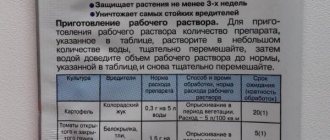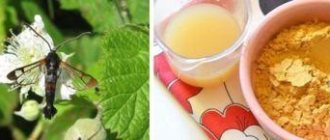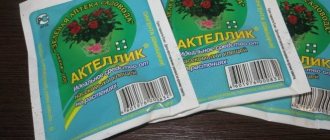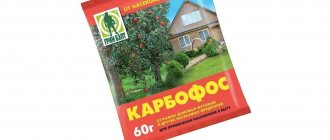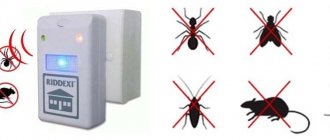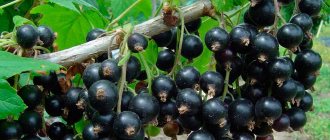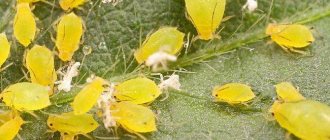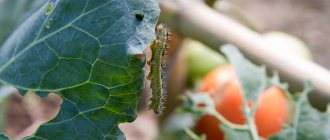Fitoverm is a brand of biological insecticidal preparations with enteric contact action. The products produced are used to combat and prevent infection by various types of garden mites and insects. Fitoverm destroys most known pests, including those dangerous for currants - aphids, spider mites, thrips and flower beetles. This concentrated substance can be diluted with water and is available in ampoules of 2 and 4 ml, as well as bottles of 20 ml. Suitable for spring and autumn processing of black, white and red currants. Can be used as an infestation of harmful insects at any stage of the plant's growing season.
Operating principle
Fitoverm is a biologically active insecticide for the treatment of agricultural, fruit and berry crops, and indoor plants. The chemical substance in its composition called aversectin has a targeted contact-intestinal effect on insects. When a pest enters the body, it causes a strong nerve-paralytic effect and also leads to disruption of digestion and metabolic processes. After the insect enters the body, phytoverm begins to act within 6-15 hours, depending on the type of pest, and leads to death after 2-3 days from exhaustion. This material will tell you about large-fruited varieties of tomatoes for greenhouses.
Repeated spraying of the bush with Fitoverm is required, since the drug does not destroy insect eggs.
The substance does not cause any harm to the plant and does not affect the taste and quality of the berries. When processing currants in dry and sunny weather, the lasting effect can last up to 15 days.
Description of the pest
This is a harmful insect from the order Homoptera, its mouthparts are of the piercing-sucking type.
Many varieties of this pest can appear in the garden, but the following types of aphids appear on different varieties of currants:
- shoot aphid
, which settles only on blackcurrant varieties; - leaf
aphid - it prefers to live on white or red currants.
Reference!
The peak appearance of this harmful insect in the garden is May-June, but aphids live on berry bushes throughout the summer.
Adults do not live long, but their females reproduce at lightning speed, so up to 15 generations of this harmful insect can appear over the summer.
Aphids can cause irreparable damage to currant bushes, especially if their colony has grown rapidly. Comfortable conditions for its reproduction are hot weather and lack of precipitation, so in the dry season, this pest will have to be fought throughout the summer season.
Compound
The active ingredient of Fitoverm is aversectin C in concentrated form. This is an extract of the mycelial mass of the soil fungus Stereptomyces avermitilis. From a chemical point of view, it is a macromolecular ether that cannot be obtained chemically. Only fungal strains numbered 54 and 51 are used as a biological insecticide. Fitoverm brand preparations have been produced since 1993, the active substance has been tested on laboratory animals. Find out about the Dutch pink currant variety at this link.
Prevention
Fighting aphids is a long and tedious task. To prevent insects from infecting berry gardens, follow these simple rules:
- Perform annual pruning of bushes, removing all damaged branches and shoots.
- Regularly pull out weeds around the bush.
- Dig up the soil under and around bushes.
- Eliminate garden ants.
- Plant aphid repellent plants.
- Let ladybugs and lacewings live in your garden.
- In spring, scald the bushes with boiling water.
- Whitewash trunks and branches.
You have learned ways to combat the currant pest - aphids. Which one to choose is up to you. Practice and experience will help you make the right choice. Fighting aphids is a methodical, responsible and constant activity. Simple preventive measures will help alleviate it.
Instructions for use for currants
Fitoverm is used for spraying vegetative parts of plants to treat and prevent infection. For currants, the optimal dosage of the drug is 1.5 ml/l when treated against insects, 2 ml/l - against ticks. Product consumption – 1 liter per bush. To prepare the solution, you need to dilute Fitoverm in water at ambient temperature, add the product in accordance with the dosage.
The procedure should be carried out in dry and windless weather, preferably in the early morning or evening. The recommended air temperature for processing is 12-25°C.
Spraying is carried out during the growing season. You need to spray currants evenly, distributing the substance onto the leaf blades from the outside and inside, all parts of the shoots. During the season, it is recommended to carry out treatment twice during the growing season (including during flowering and fruiting) with an interval of 14 days.
It is most convenient to carry out the work with a fine spray.
Storage after spraying
For storage, you need to choose a dry and cool place where ultraviolet rays do not penetrate. The air temperature in the room can vary from -130C to +300C. The product should be stored away from food products. It should be inaccessible to small children and animals.
After dilution, the liquid solution must be completely used; storage is not recommended. After release, the container is destroyed. The main thing is not to stand nearby and not inhale combustion products. Do not throw into water bodies or sewers.
Toxicity of the drug
Fitoverm belongs to class 3 danger for humans. This is a conditional value that is calculated solely from the average lethal dose, but does not take into account allergies or individual intolerance to the drug for humans. Find out about methods of growing Indian onions here.
During work, you should use personal protective equipment: gloves, respirator.
After spraying the currant planting, you need to wash your face and hands with soap, and also rinse your mouth. If the insecticide gets into the gastrointestinal tract, induce vomiting and then take an absorbent drug. If side effects occur, you should consult a doctor. Storing the prepared composition is not allowed; it is not recommended to let the product into open water.
Sea buckthorn processing
To protect bushes from spotting, scab and fruit rot, before buds open, treat with a 3% solution of copper sulfate or a 5% solution of iron sulfate. Secure the effect with another treatment carried out before flowering - use a solution of Agrolekar, Strobi, Bayleton, Fitosporin or Gamaira.
To repel the attack of the sea buckthorn honeydew, sorrel bug, leaf roller and aphid, during the period of swelling of the buds, thoroughly moisten the above-ground part of the plants with a solution of Fufanon-Nova, Iskra Double Effect or Kinmiks. As an option - Bitoxibacillin or Fitoverm.
Sea buckthorn in the open ground - all about planting, care and reproduction Sour, prickly, rapidly growing - is this exactly what you imagine sea buckthorn to be? Your information is quite outdated, now she is completely different!
How is it different from Fitoverm CE?
There are several versions of the traditional drug Fitoverm. The letter designation next to the name indicates the specialization of the active action, since some types of currant pests are resistant to insecticides. This article will tell you about the treatment of currant chlorosis.
When choosing a drug for treating currants, you should take into account not only the degree of damage, but also the type of pest. This allows you to achieve not only visible results, but also avoid re-infection.
The products differ only in the concentration of the active substance.
For example, Fitoverm CE is an insectoacaricide; it effectively destroys not only insects, but also herbivorous mites. Fitoverm P is a drug designed to combat nematodes, which are extremely resilient and resistant organisms.
What is it needed for
Before using the drug Fitoverm, it is recommended to read the instructions for use. This is an insecticidal agent of biological origin with multifunctional action.
It affects all types of pests that predominate in our regions. Effectively fights against:
- aphids of all kinds;
- Colorado potato beetle;
- caterpillars;
- leaf rollers;
- mealybugs;
- thrips;
- codling moths;
- scoops;
- harmful butterflies;
- moth;
- Fitoverm is effective against ticks of all types.
conclusions
- Fitoverm is a group of insecticidal preparations for the treatment of vegetable, ornamental and fruit plants. Depending on the labeling, the substance destroys most known harmful insects.
- Aversectin C as part of the product has a contact-intestinal effect on pests. Leads to their paralysis and death within 2-3 days from the moment of treatment.
- The optimal dose for spraying currants is 1.5 ml/l against insects, 2 ml/l against mites and nematodes. The processing is carried out in two stages.
- The product has toxicity class 3; a respirator and gloves should be used when working. In case of contact with skin or eyes, rinse with plenty of water.
- Among the direct analogues of Fitoverm are the preparations Vermitek, Abacus or Zephyr. But to prevent pest infestation, other synthetic, biological insecticides can be used.
Read about processing currants with ammonia here.
Fighting aphids
Watering with boiling water
You can water currants and gooseberries with boiling water when there is still snow on the site, and in the trunk circles of the fruit bush the snow has thawed (about 70 cm in diameter). Those. the snow on the branches has already melted, but the buds are still dormant and have not swelled!
Heat the water to a boil, pour it into a watering can with a sprinkler attachment. Then immediately water the bushes along the branches and the soil around the bushes. It takes about one watering can for a small bush. When pouring boiling water into a cold metal watering can, the water temperature drops to about 80 degrees; when watering the branches, its temperature drops to 70 degrees.
This technique allows you to destroy not only aphid eggs preserved on the shoots, but powdery mildew spores and mite clutches.
You can add 3 drops of iodine to 10 liters of water for other diseases
It is important not to keep the watering can strictly in one place when watering, i.e. you need to scald, and not rinse the branches in boiling water!
Ash dusting
In the spring, before the leaves fully bloom (you can at the stage of bud opening), wet the branches with water and dust the moisture with sifted wood ash.
Soap and ash solution for aphids
Pour 300 g of ash (2 cups) into a bucket with 10 liters of boiling water, add 50 g of laundry soap shavings and leave to steep overnight. Pour the solution into the sprayer through triple gauze so as not to clog the sprayer with grains of ash. Treat all branches during bud break, at the stage of young leaves (salad greens).
Treatment against aphids with soap and Domestos
For 10 liters of water, take 100 g of tar or black laundry soap, add 5 drops (with a pipette) of Domestos (or any preparation containing chlorinol). You can spray on bare branches even at the moment when the leaves have already blossomed. 10-15 minutes after treatment, wash off the leaves with clean water from a hose. The procedure can be repeated after a couple of days.
Ammonia
Another proven way to combat aphids is ammonia. Two tablespoons per bucket of water, add 1 tbsp. a spoonful of liquid soap. Helps almost instantly. No need to rinse off.
Dog shampoo against aphids
Flea shampoo for dogs and cats contains active ingredients of the pyrethroid class, they are toxic to aphids, i.e. the composition of the solution will be the same as, for example, a solution of the insecticide Iskra. The only difference is that the shampoo contains surfactants, i.e. adhesives. It is quite difficult to calculate the dose of shampoo (the concentrations of the active substance are different).
The safe dosage for plants is approximately 1 tbsp. spoon per bucket of water (10 l). Higher concentrations may cause leaf burn!
Literature
- Popov S.Ya., Dorozhkina L.A., Kalinin V.A. “Fundamentals of chemical plant protection”, Moscow “Art-Lion”, 2003.
- Zinchenko V.A. “Chemical plant protection: means, technology and environmental safety”, Moscow “Kolos S”, 2005
- “STATE CATALOG OF PESTICIDES AND AGROCHEMICALS AUTHORIZED FOR USE IN THE TERRITORY OF THE RUSSIAN FEDERATION
- Shulgina O. A., Andreeva I. V., Shatalova E. I. “Suppression of the number of cabbage phytophages by phytoverm in the conditions of the south of Western Siberia,” “Achievements of science and technology of the agro-industrial complex,” 2010
- Dogadina M.A. “Environmentally safe protection of roses from pests”, Bulletin of the Oryol State Agrarian University, 2015
Pros and cons of Fitoverm
Fitoverm is a fourth generation pest control product , the main advantage of which is its minimal harmful effect on the soil, flora and beneficial fauna of the site.
Among the advantages of the drug we can also highlight:
- High efficiency and a long list of pests destroyed.
- Versatility. Suitable for use on all plants in the garden, garden and home; it does not inhibit their development.
- Dual mechanism of action - through the skin and intestines of insects.
- The long period of plant protection - up to 20 days - allows you to get by with only 2-3 treatments per season.
- Complete safety for plants.
- Rapid deactivation - the crop is safe to harvest within 48 hours after treatment, does not accumulate in either fruits or foliage.
- Convenient packaging. You can choose the volume of the drug that is needed for your purposes.
- No addiction. The effectiveness of the pesticide does not decrease over 5-6 seasons of consistent use.
- Good compatibility with most drugs on the market.
- It is especially effective in hot weather, unlike most chemical products.
Despite all these advantages, Fitoverm does not solve all pest problems due to some disadvantages:
- Photoinstability, that is, the drug instantly decomposes in light.
- Instability on leaves. The solution adheres weakly to plants and is quickly washed away by precipitation and dew. Therefore, it is recommended to add soap or store-bought adhesives to the liquid.
- Selectivity in action. Pest larvae and eggs do not take part in feeding, so some of them survive treatment. Ticks also often hide in the veins of leaves, so many individuals manage to avoid contact with the poison.
- Expensive. Especially in comparison with similar drugs based on nuclear chemistry.
- Unpleasant (although not strong) odor.
- Toxicity to bees and other pollinators.
- Cannot be applied to the soil.
- The working solution is not stored for longer than one day.

